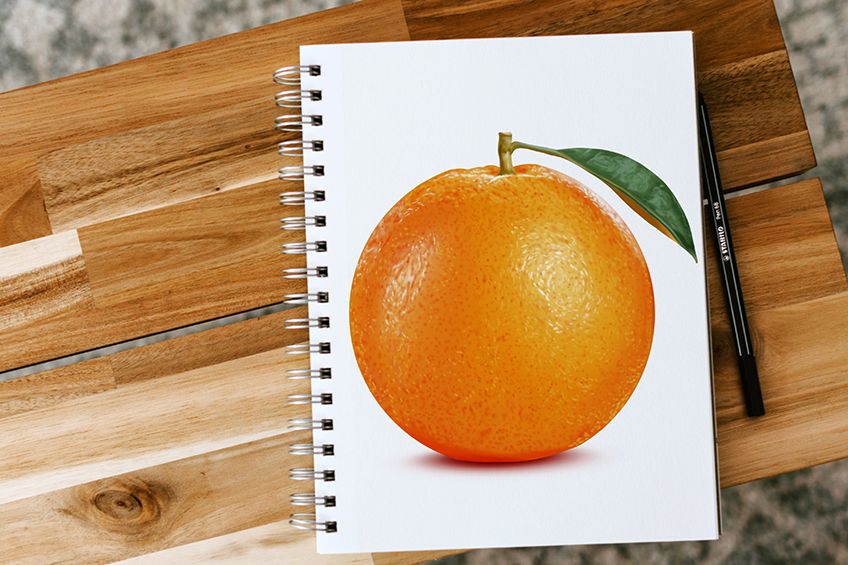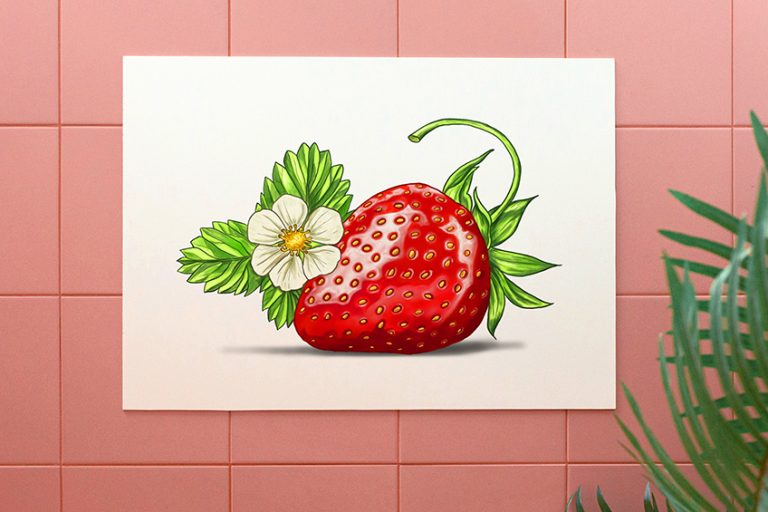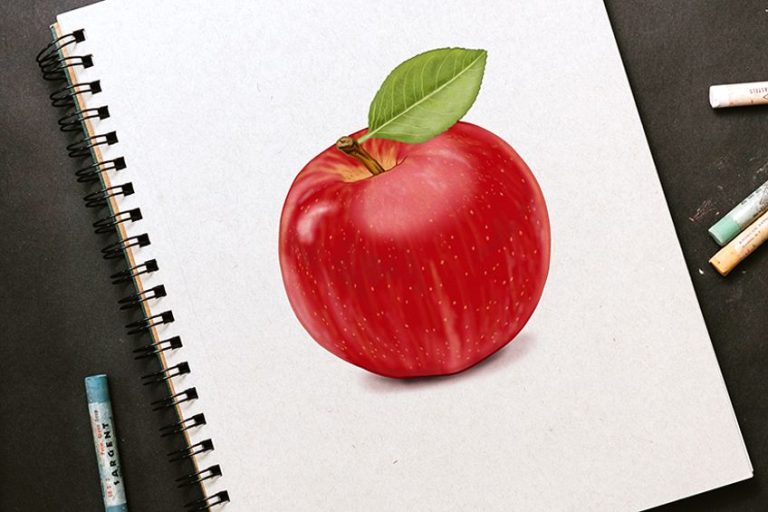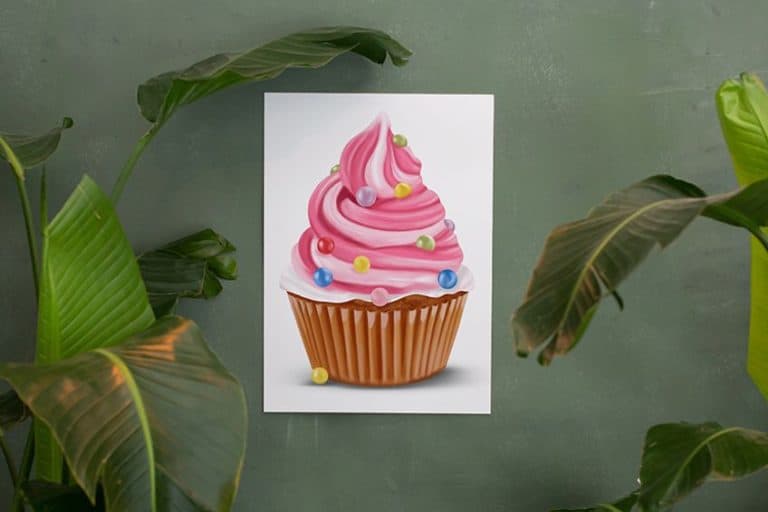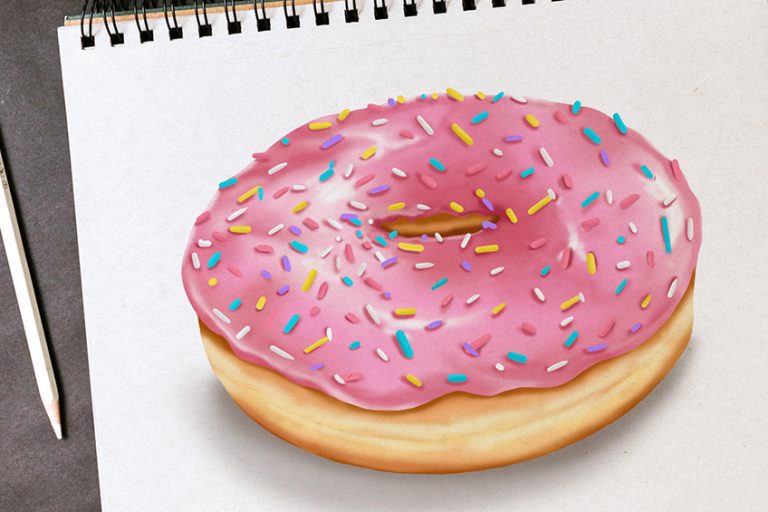How to Draw an Orange – A Juicy and Realistic Orange Drawing Tutorial
In this next installment of our fruit drawing series, we have a realistic orange drawing tutorial! Oranges are sweet and juicy fruits, packed with vital nutrients like vitamin C. Oranges are also one of the only objects in this world that are the same color as their name suggests. We begin by guiding you through the orange outline drawing process, before adding bright color to our orange sketch. Without any further ado, let us begin!
Table of Contents
- 1 Realistic Orange Drawing Tutorial in 16 Easy Steps
- 1.1 Step 1: Draw the Main Shape of Your Orange
- 1.2 Step 2: Define the Shape of Your Orange Drawing
- 1.3 Step 3: Outline the Stem
- 1.4 Step 4: Shape the Leaf of Your Orange Sketch
- 1.5 Step 5: Apply a Base Coat of Orange
- 1.6 Step 6: Add Color to the Stem
- 1.7 Step 7: Color Your Orange Leaf
- 1.8 Step 8: Begin Creating Some Dimension
- 1.9 Step 9: Highlight Your Orange Drawing
- 1.10 Step 10: Begin Texturing Your Orange Drawing
- 1.11 Step 11: Highlight Your Texture
- 1.12 Step 12: Finish the Stem Details
- 1.13 Step 13: Add Texture to the Orange Leaf
- 1.14 Step 14: Finish the Leaf
- 1.15 Step 15: Add a Shadow to Your Orange Fruit Drawing
- 1.16 Step 16: Finish Your Realistic Orange Drawing
- 2 Frequently Asked Questions
Realistic Orange Drawing Tutorial in 16 Easy Steps
Today we show you how to draw a realistic Orange! In this tutorial, we will cover the basic steps of creating an orange sketch including setting up the basic shape, coloring, and then highlights and shading! The result will be a hyper-realistic orange drawing that makes you want to reach out and grab it. You can see an outline of our orange drawing tutorial in the collage below.
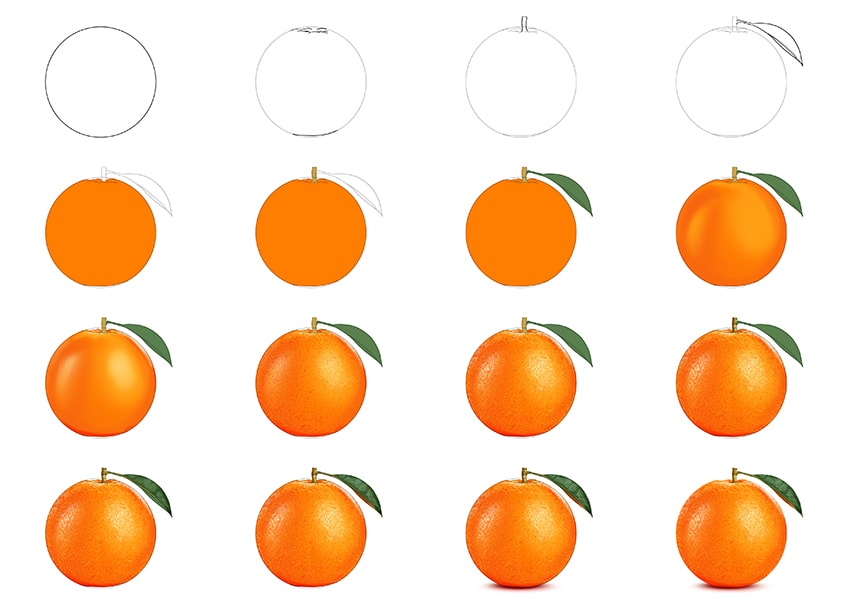
You will see that most of this orange drawing tutorial involves coloring. When it comes to these coloring steps, you have a wide range of choices for the medium. We suggest that you use the medium that you feel most comfortable with, as we will be exploring some fairly complex shading and highlighting skills. If you prefer to work on a digital drawing tablet or you are a more physical artist who uses acrylic paint, then you can simply adapt the steps to suit your own unique needs.
Gather up your drawing supplies, and let us being our realistic orange drawing.
Step 1: Draw the Main Shape of Your Orange
In the very first step of our orange sketch tutorial, you are going to draw a large circle. In some ways, this step is really simple, but in other ways, it can be quite tricky. If you do not feel comfortable drawing a circle freehand, then you can trace a round object. Find the very center of your drawing canvas, and draw this large circle as lightly as possible.

Step 2: Define the Shape of Your Orange Drawing
Now that we have the circle base for our orange sketch, it is time to create a slightly more realistic shape. As with most things in nature, oranges are not perfectly round. Because we want to create a realistic orange drawing, it is essential that we make the shape a little more natural. Begin this step at the bottom of the large circle, drawing a curved line that dips in slightly from the outer edge of the circle. This should flatten the bottom of your orange sketch ever so slightly. Finally, at the top of the circle, draw several creases and stretch lines.
These lines will represent the small dip at the top of the orange where the stem emerges.
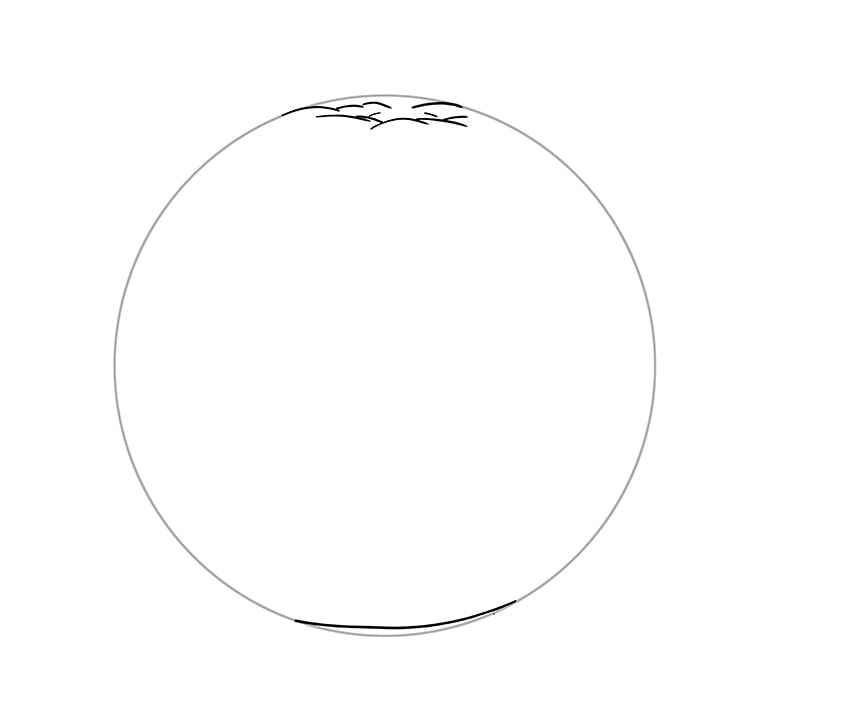
Step 3: Outline the Stem
You created the natural dip at the top of the orange sketch in the previous step. You are now going to use that dip to place the stem. Between these top creases, draw a short stem that extends upwards from the orange with a squared-off edge.

Step 4: Shape the Leaf of Your Orange Sketch
Now that you have the stem in place, you can draw the outline of your leaf. From the right side of the stem, draw a single large leaf that curves down around the side of the orange. Within the bottom portion of the leaf, you can draw a centerline.

Step 5: Apply a Base Coat of Orange
Your outline is now complete, so it is time to add a single layer of base color to your orange outline drawing. Use a regular brush and some orange paint, and carefully fill the entire shape of your orange sketch.
Remember to leave the stem and the leaf blank, as we will color these separately in the next few steps.

Step 6: Add Color to the Stem
In this very quick step, you are simply going to fill in the shape of the stem with a light, caramel brown color.
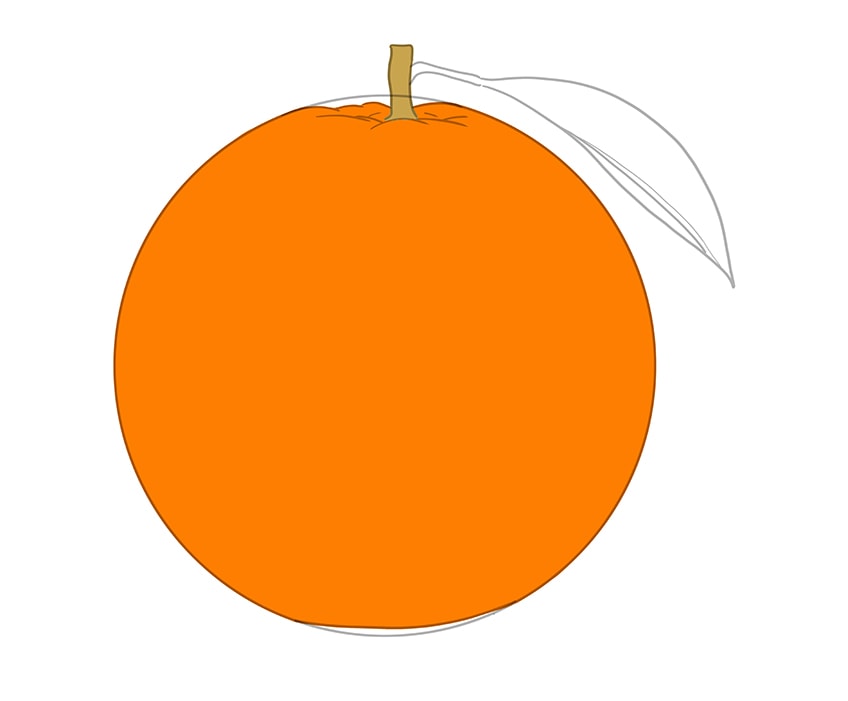
Step 7: Color Your Orange Leaf
To complete the base coat for your realistic orange drawing, find a shade of pine green color and fill the leaf shape with an even coat.

Step 8: Begin Creating Some Dimension
You can see that at the moment, your orange drawing is looking a little flat and two-dimensional. In this step, we are going to begin adding some shadows and highlights to bring your realistic orange drawing to life. Find a blending brush and a slightly darker shade of orange, and carefully apply some soft strokes of shading within the main body of your orange sketch.
Focus these shadow strokes around the edge of your orange, and ensure that they follow the curve of the fruit for additional realism.

Step 9: Highlight Your Orange Drawing
In the previous step, you began to add some shading. In this step, you are going to add the first layer of highlights and darken some areas of shading. Begin with a small blending brush and an even darker shade of orange than the previous step. Carefully apply an additional layer of shading around the edges of your orange to add some more structure. Next, use a clean blending brush and some white paint to apply spots of highlight to the areas of your orange drawing that would naturally catch the light. These areas include patches in the center of your orange and the creases at the top.
Once you have finished, you can use a clean blending brush to gently soften the blend between your different colors.

Step 10: Begin Texturing Your Orange Drawing
In this step, you are going to start adding textural detail to the skin of your orange sketch. There are several ways to do this depending on the coloring medium that you have chosen. If you are working digitally, simply use a rough brush with a high spread and a darker shade of orange to add random fine-textured dots to the skin. For more physical mediums, use a very fine brush and manually dab on small dots throughout your realistic orange drawing.
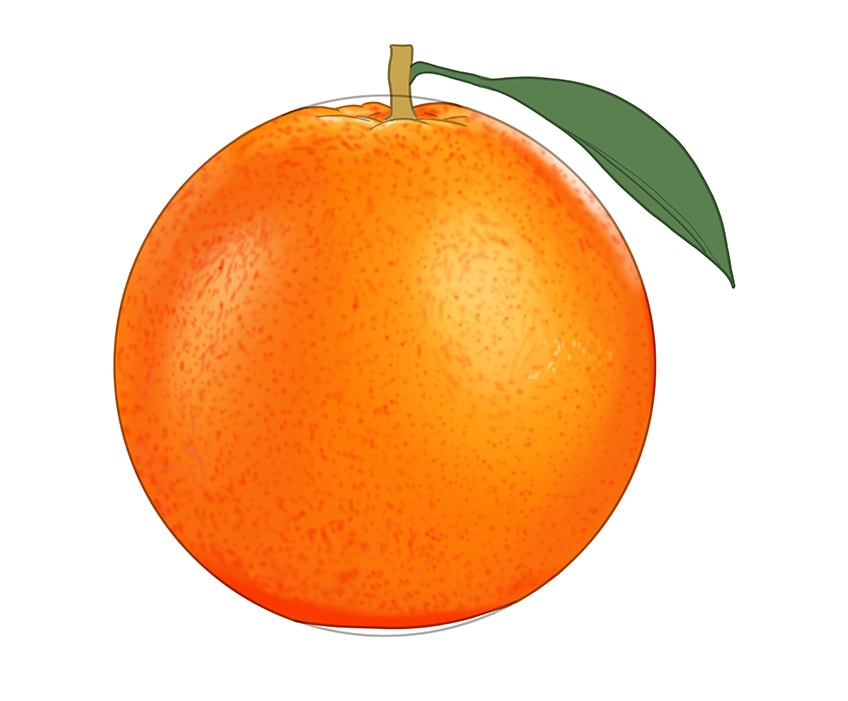
Step 11: Highlight Your Texture
Using a small blending brush and some very light orange paint, add some fine dots and streaks on top of the texture coat. Next, using a small blending brush and some white paint, repeat this process on the lightest spots of the orange.
Remember that these highlights should correspond with the highlights in the base color.

Step 12: Finish the Stem Details
Using a small soft brush and a darker shade of olive-brown paint, apply several brush strokes along the top and bottom edges of the stem. This will enhance the structure. Then, using a small clean blending brush, carefully smooth the different colors together.

Step 13: Add Texture to the Orange Leaf
With a small soft brush and the same olive-brown color, carefully shade the centerline of the leaf, all the way up to the stem. Complete this step by using a small blending brush and a touch of black paint to add texture to the leaf.
The first color coat should still be somewhat visible.

Step 14: Finish the Leaf
With a small blending brush and some white paint, lightly soften the side wall of the leaf. Finish this step by gently adding some orange paint to the underside of the leaf. This should give the impression of the orange fruit drawing reflecting onto the leaf.

Step 15: Add a Shadow to Your Orange Fruit Drawing
Using a small soft brush and a darker shade of orange, apply a casted shadow at the very bottom base of the orange. This should increase the realism of your orange sketch!
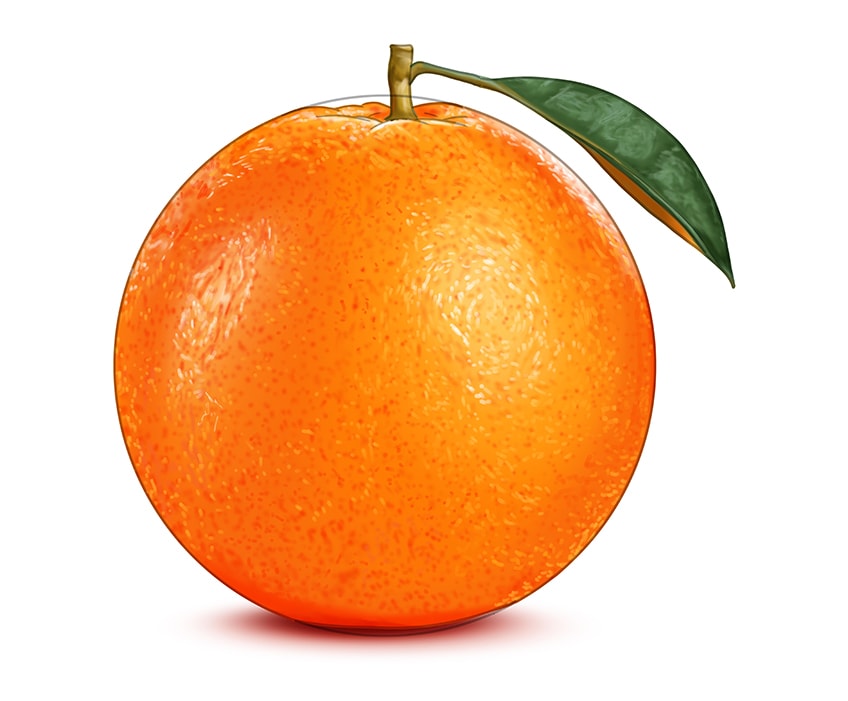
Step 16: Finish Your Realistic Orange Drawing
To complete your orange fruit drawing, you can now erase the outlines. Trace over the lines with a sharp brush and the corresponding color at each point. You can erase all of the visible black lines, including those in the stem and leaf.
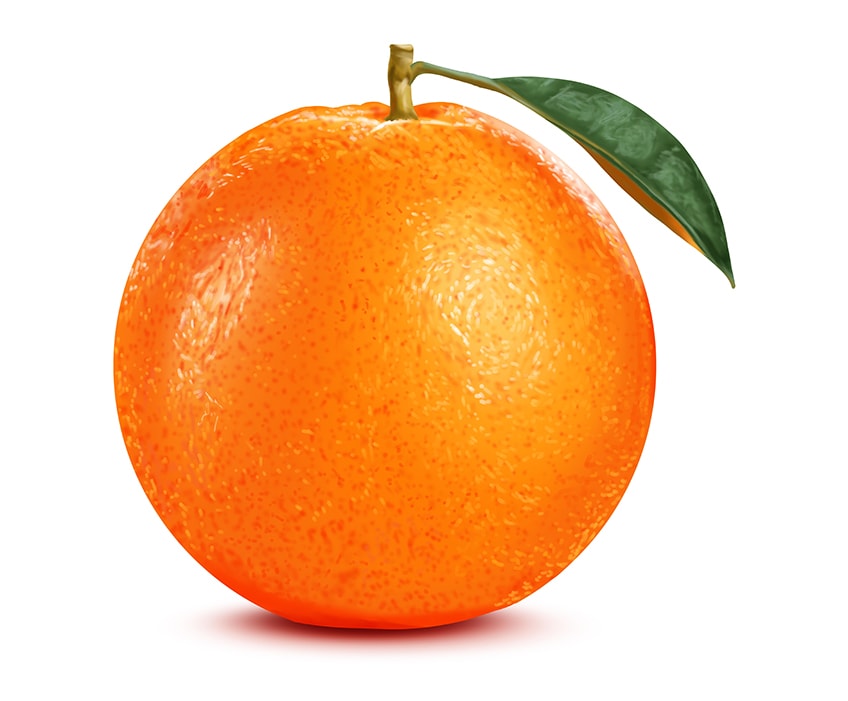
Just like that, you have just completed an easy and very realistic orange fruit drawing. We hope that you have enjoyed the process, and perhaps like us, you are now craving some sweet and refreshing orange juice! The same methods of construction and color building apply to all drawing endeavors, so go out and use your new skills to capture the beautiful world around you.
Frequently Asked Questions
How Do You Start an Orange Fruit Drawing?
Starting any drawing is often the hardest part. In our tutorial, we show you how to carefully construct your base shapes before diving into the deep end. After you have your orange outline drawing complete, you can then begin to add color and texture to your realistic orange drawing.
How to Create an Easy Orange Sketch?
In all of our drawing tutorials, we work to make complex objects very simple to draw. Our orange drawing tutorial is no different! We break the drawing process down into quick and easy-to-follow steps, and before you know it, you will have a beautiful and realistic orange drawing.
Matthew Matthysen is an educated multidisciplinary artist and illustrator. He successfully completed his art degree at the University of Witwatersrand in South Africa, majoring in art history and contemporary drawing. The focus of his thesis was to explore the philosophical implications of the macro and micro-universe on the human experience. Matthew uses diverse media, such as written and hands-on components, to explore various approaches that are on the border between philosophy and science.
Matthew organized various exhibitions before and during his years as a student and is still passionate about doing so today. He currently works as a freelance artist and writer in various fields. He also has a permanent position at a renowned online gallery (ArtGazette) where he produces various works on commission. As a freelance artist, he creates several series and successfully sells them to galleries and collectors. He loves to use his work and skills in various fields of interest.
Matthew has been creating drawing and painting tutorials since the relaunch in 2020. Through his involvement with artincontext.org, he has been able to deepen his knowledge of various painting mediums. For example, watercolor techniques, calligraphy and lately digital drawing, which is becoming more and more popular.
Learn more about Matthew Matthysen and the Art in Context Team.
Cite this Article
Matthew, Matthysen, “How to Draw an Orange – A Juicy and Realistic Orange Drawing Tutorial.” Art in Context. June 9, 2022. URL: https://artincontext.org/how-to-draw-an-orange/
Matthysen, M. (2022, 9 June). How to Draw an Orange – A Juicy and Realistic Orange Drawing Tutorial. Art in Context. https://artincontext.org/how-to-draw-an-orange/
Matthysen, Matthew. “How to Draw an Orange – A Juicy and Realistic Orange Drawing Tutorial.” Art in Context, June 9, 2022. https://artincontext.org/how-to-draw-an-orange/.


